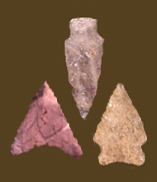
|
HALIFAX
Chronology The Halifax point dates to the Middle and Late Archaic periods. McAvoy and McAvoy (1997) found Halifax points in numerous features radiocarbon dated between 5500 and 4850 BP (approximately 4350-3600 BC in calendar years) along the Nottoway River in Virginia. At site 44PW1292, located near the Potomac River on Quantico Marine Corps Base in Virgina, 20 Halifax points were found in contexts that produced five radiocarbon dates between 5020 and 4770 BP, or 3850-3550 BC calendar (Bedell et al. 2014). A radiocarbon date of 5440 +/- 350 BP was obtained from a Halifax provenience at the Gaston site in North Carolina Coe (1964). Description Haft Element: The base is typically ground. It is usually straight or slightly concave, and is a little narrower than the maximum width of the blade. The broad and shallow side notches are also frequently ground. Notches begin at the point of maximum width and continue to the base. In some examples, the point seems more stemmed than notched. Size: Length ranges from 29 to 56 mm, with an average of 44 mm. Width ranges from 17 to 25 mm, with an average of 20 mm. Thickness ranges from 8 to 11 mm. Technique of manufacture: Soft percussion and pressure flaking; a typical Halifax point is relatively thick, and was made from a core rather than a thin flake. Material: In the Monocacy River drainage, 47% of 43 Halifax points were quartz, with 42% rhyolite and 11% chert (Kavanagh 1982). The Halifax points in the middle Potomac Valley are commonly quartz, but also appear in quartzite and rhyolite (Hranicky 2002:149). Discussion The Halifax has been described as a shorter, notched version of the slightly earlier Guilford point, and the similarities between Guilford, Halifax, and Savannah River points may indicate a certain degree of Archaic period cultural continuity (Ward and Davis 1999). Similarity with the Vernon point has also been noted, and some researchers combine the two types (Wanser 1982; LeeDecker and Koldehoff 1991). The “Type C” points from the Higgins site in Anne Arundel County were similar to the Halifax, but had a more deeply indented base (Ebright 1992). Defined in Literature References |
![]()
Search by Shape:
(See Projectile Point Typology) |

|
Thank you for visiting our website. If you have any
questions, comments, Copyright © 2002 by |

|

 Defining Attributes
Defining Attributes